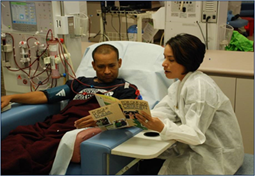For Professionals in Nephrology, Dialysis, and Transplant: A discussion of CMS ESRD QIP changes that could impact your funding and the Toolkit that will help you be ready
CMS requires dialysis centers to increase patients wait-listed for transplant
Earlier this year, the Centers for Medicare and Medicaid Services (CMS) announced that, as part of its ESRD Quality Incentive Program (QIP) starting January 1, 2020, dialysis facilities will be required to report their Percentage of Prevalent Patients Waitlisted (PPPW) on the kidney or kidney-pancreas transplant waitlist. The PPPW is a way to track trends in the number of patients on the transplant waitlist over time. It is calculated as the percentage of patients at each facility who are on the kidney or kidney-pancreas waitlist in a given reporting period, divided by the average number of patients on the list on the last day of the month each month in the last reporting year.
The goal of this new criterion for evaluation is to increase the equity of care and promoting patient health by providing financial incentives for dialysis facilities to deliver high-quality patient care. The new reporting requirements authorize CMS to reduce payment reimbursements to facilities that are not meeting the minimum Total Performance Score (TPS) as set forth by CMS. Payment reductions can be as much as 2% and will go into effect 2022.
The upshot: dialysis centers need to figure out how to start increasing the number of their patients who enter the transplant waitlist in order to maintain full CMS funding.
Good for dialysis centers & good for patients
Increasing the number of dialysis patients on the waitlist for kidney transplant is a win-win: more chronic kidney disease (CKD) and end stage renal disease (ESRD) patients will be primed for transplant, which provides better health outcomes than prolonged dialysis, and dialysis centers can maintain maximum funding from CMS. Additionally, for centers already struggling to meet the dialysis needs of all the patients within their catchment area, getting patients on the waitlist and eventually transplanted lessens the burden on centers running at maximum capacity.
Know what to do with the help of the new Kidney Transplant Toolkit
The Kidney Transplant Toolkit is an essential tool for dialysis centers looking to improve their offerings and communications with patients in order to boost the number of patients entering the transplant waitlist. The Toolkit explains why transplant and specifically living donor kidney transplant (LDKT) is the gold standard treatment option for many patients. The Toolkit also gives an overview of the kidney transplant landscape, including disparities in access and receipt of transplants by Black, Hispanic, and other patients from minority groups. You can use the toolkit as a guide for learning about how to create health education about wait-listing and transplant that is geared to the appropriate Stage of Readiness for each patient and why tailoring education in this way matters. Included is an assessment tool for determining Stage of Readiness based on the tenets of the Transtheoretical Model (TTM) of behavior change.
The Toolkit details everything from the basics of what transplant is, why it improves health outcomes, how to prepare health literate patient education, discussion of sensitive groups who may require special outreach, how to assess patient readiness level, and how to tailor communication to each readiness stage.
The toolkit also includes an extensive list of resources that can be shared with patients to help them:
- Learn about kidney disease
- Learn about kidney transplant
- Find specific resources on living donation
- Locate financial resources for transplant and living donation
- Find the nearest transplant center
In addition to these resources, we also offer in-person trainings and educational information for healthcare professionals, which you can learn more about here. With the help of the Kidney Transplant Toolkit, you will be better prepared to educate your patients about their treatment options and to meet the new ESRD QIP requirements for increasing the number of wait-listed patients at your center.


